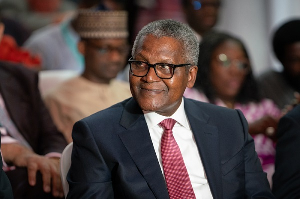Undoubtedly, one of Ghana’s cherished and priced heritage is Kente. It is a woven cloth with many beautiful brightly-patterned colours with different meanings.
Its origin has been traced to the Ashanti ethnic group of Ghana but has largely been contested by Ewe historians who claim the craft was learnt by the Ashantis from them.
The Kente cloth is known in Akan as nwentoma which means woven cloth which is made from silk, cotton or rayon fabric.
In the Ashanti version of its origin, legend has it that some two friends came across a giant spider (Ananse) weaving her web, when they went hunting in the forest. Amazed by the craft, they stayed and studied how the spider wove, returned after 2 days and imitated the animal with a first cloth which was woven out of raffia, which they presented to the first Asantehene.
The Ewes however say the name ‘Kente’ is originally an Ewe word from 2 syllables; ‘Ke’ and ‘te’ which means to ‘expand’ and ‘compress’. The name, according to historians, originates from the way the loom is operated to get the nicely woven clothes.
There are various types of Kente and they come in various colours. Though every cloth is a blend of more than one colour, some colours dominate more than others. Here’s what’s even more interesting, every colour has a unique meaning and every pattern too!
Let’s break it down:
Adwinasa:

According to Kentecloth.net, this cloth Literally means “all motifs are used up.”
According to historians, the designer of this cloth, attempted to weave a unique cloth to please the Asantehene. In his effort he used all the motifs then known to weavers in weaving one cloth. In the end, he remarked that he had exhausted all the repertoire of motifs known to Asante weavers.
The cloth was, therefore viewed as one of the topmost quality, and the most prestigious of kente cloths, besides those woven exclusively for Asante Kings. It was in the past, worn by kings and people of high status and wealth.
Obi nkye obi kwan mu si:

The literal translation of this is to err is human, depicting the human phenomenon where people inevitably offend one another. To err is human, and therefore, one should be conciliatory when one is offended. For sooner or later one may be the offender to the other.
Oyokoman na gya da mu:

This means there is crisis in the Oyoko nation. The name of this cloth commemorates the civil war after the death of Osei Tutu between two factions of the Oyoko royal family. One faction was headed by Opoku Ware and the other by Dako.
Sika fr3 mogya:

This literally translates; “Money attracts blood relations or Wealth strengthens the family bonds. When one succeeds, one has responsibility to share one's success with one's relatives.
Achimota Nsafoa:

This is the Akan phrase which means Achimota keys. This design commemorates the Achimota School and College which was opened in 1927. The motif represents the logo of Achimota the black and white keys of the piano. One can make melody on either the black or white keys of the piano, but one can make harmony by playing together both the black and white keys of the piano.
Emaa da:

It has not happened before" or "it has no precedence.
According to Nana Kwasi Afranie of Bonwire, the Asantehene's chief weaver, the cloth was designed and so named by one of the Asante Kings who was so awed by the uniqueness of the pattern that he remarked "Eyi de emmaa da" meaning, "this one has no precedence." The cloth was therefore reserved for the exclusive use of the King, but its use was later extended to people of high ranks.
Toku kra toma:

It translates in English as “Toku's soul cloth”.
The cloth is designed and named to commemorate the soul of a warrior Queen mother of that name, who, though was defeated and executed in a battle with Nana Opoku Ware I, the King of the Asante kingdom viewed her as a courageous woman. It commemorates that historic event and honours the soul of that Queen mother for her bravery.
In the past, such a cloth would only be worn by the royalty and people of high rank during very sacred ceremonies in which the spirits of the ancestors are venerated.
Wofro dua pa a na yepia wo:

One who climbs a tree worth climbing gets the help deserved.
The cloth was designed to express the Akan social thought which maintains that any good individual effort deserves to be supported by the community. When one climbs a good tree that has fruits on it, people around will give him a push, since they know they will enjoy the fruits of his labour. It is a notion that reinforces the importance of aspiring towards a worthy course.
Kyeretwie

The lion catcher. The cloth was designed to commemorate an incident during the reign of King Kwaku Dua (1838 -1867) who tested the courage of his warriors by ordering them to catch a leopard alive. The appellation, "Kyerekwie" was since appended to the names of some of the Asante Kings whose bravery and leadership qualities were comparable to the courage needed to catch a leopard alive.
The black vertical warp stripes represent the black sports in a leopard's fur. In the past, the cloth was worn only by the Asantehene or by other chiefs with his permission.
Akyepem:

This means “Thousands shields”.
This is a reference to shields used by highly well-organized militia consisting of thousands of men and women who defended the Asante Kingdom against external aggression. According to the military strategy of the Asante Kingdom, the chief of the shield bearers, the Akyempemhene, and the rear guards of the King are his own sons.
Shields once used as military weapons are now used in royal ceremonies to symbolize and commemorate the military prowess of the Asante Kingdom.
Nyankonton:

God's eye brow (the rainbow).
It was created in exaltation of the beauty and mystery of the rainbow phenomenon. The arrangement of warp threads mimics the visual characteristics of the rainbow.
Akokobaatan:

This means “mother hen”. It translates to the intention of a mother hen when she steps on the feet of her chicks; she does not mean to kill them. In day-to-day relation, it means that a parent does not intend to harm a child when they correct them. It also portrays the mother’s love for her children.
Obaakofo mmu man:

It means “one person does not rule a nation”
This pattern expresses the Akan system of governance based on participatory democracy. The nine squares represent MPUANKRON (nine tufts of hair) a ceremonial haircut of some royal functionaries who help rulers make decisions.
Originally the cloth was named FATHIA FATA NKRUMA. "Fathia is a suitable wife for Nkrumah." After the military overthrow of Nkrumah, the original significance of MPUANKRON (participatory democracy) was developed.
Sika futoro:

This means gold dust. Before the use of coins and paper as money, gold dust, was used as a medium of exchange among the Akan peoples and was therefore considered as a symbol of wealth and prosperity. The predominant use of intricately textured patterns in yellows, orange and reds replicate the visual characteristics of gold dust.
Abusua ye dom:

It means “The extended family is a force”. Among the Akans, the extended family is the foundation of society. Like a military force, members of the family are collectively responsible for the material and spiritual well-being, the physical protection and the social security of all its members.
The cloth was designed to celebrate and reinforce such positive attributes of the extended family system.
General News of Tuesday, 30 March 2021
Source: www.ghanaweb.com













